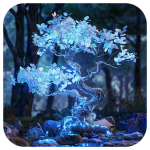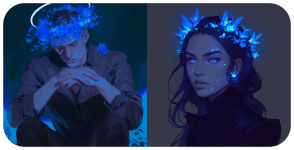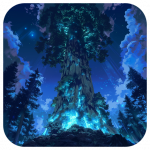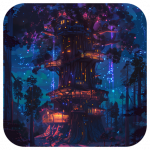
Death’s Kiss
Habitat:
Grows naturally in extremely dangerous areas of jungles and forests. It is an incredibly rare plant with bioluminescent varieties in Ælheim.
Size:
The plant itself is a vine that snakes its way up trees around it with seemingly limitless length. It produces fruit that is about an inch in diameter.
Biome Role:
Death’s Kiss wraps its vines around surrounding plant life and slowly drains them of their life force. It does not completely kill its hosts, keeping them alive but preventing them from growing further.
Life Cycle:
The vines grow slowly over the course of years. It only bears fruit after it’s absorbed enough life force, typically once every year or so.
Cultural Significance:
It used to be a common tool used by renowned assassins, but it is only used sparingly in current times. Most people know what this fruit looks like based on descriptions of it alone and that if they see black mist coming out of their food they shouldn’t eat it.
Description:
The plant itself is a vine, though it’s really known for its uniquely shaped black fruit. Death’s Kiss is a highly deadly fruit that emits a black mist even if it’s cooked/processed. It causes organic matter to decay rapidly on contact. Even so, it smells delightful and tastes divine, by all accounts. Legendary chefs have managed to extract the flavor of the fruit and add it to their foods without ill effect.
Harvesting:
CR5 to properly grow, harvest, process, and use
Notable Features:
- The fruit emits black mist, signifying danger no matter how it’s processed.
- Incredibly tasty.
- The fruit is incredibly deadly to consume, often resulting in death in minutes to hours, depending on one’s resistance skill. It can be made into a paste that causes organic matter to decay with even slight exposure.
- Druids still need appropriate medical skill to appropriately put this fruit to use without harming themselves.
Wild Magic Name: Death's Mist
Drawbacks
Name: The fruit already requires Master medical skill to use properly. Druids are granted natural resistance to the plant's effects, but since this is creating such a high concentration of mist they must have sufficient resistance skill to prevent poisoning oneself. The resistance skill is not required if the user has full mastery of the ability.
Abilities
Minor – Laced Mist: The druid can intertwine the mist's effects into their floramancy, such as creating a wooden dagger who's edge is poisoned and gives off a black mist (see below for effects).
Major – Mist Breath: The druid cultivates a concentration of black mist in their lungs and expels it from their mouth. The mist is emitted in a cone 25' long and wide. Those who inhale the mist or have it touch an open wound would suffer the same effects as someone who'd consumed the Death's Kiss fruit. The severity is dependent on the victim(s)' resistance stat:
Novice: Death within 30 seconds as their insides rapidly decay.
Apprentice: Organ failure within ten minutes.
Journeyman: Rotting that spreads over the course of a day. Deadly if not treated.
Expert: Rotting that spreads over the course of a week. Deadly if not treated.
Master: Some rotting at the wound site / lungs, nothing life threatening.
Grandmaster: No effect




